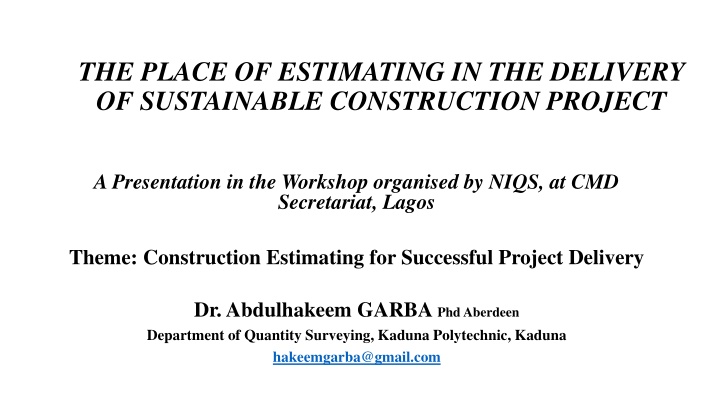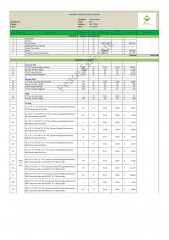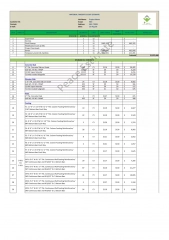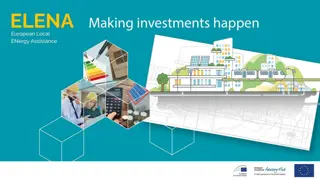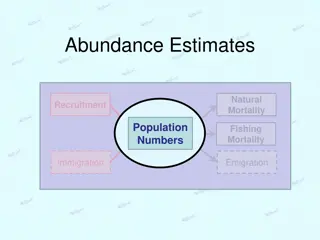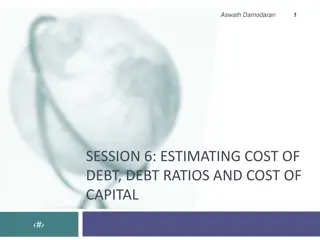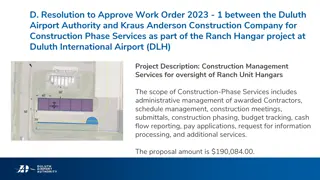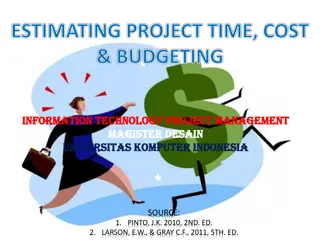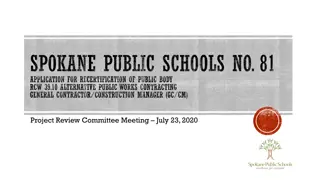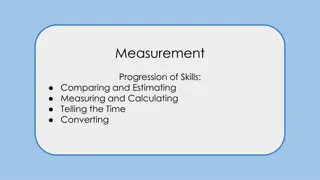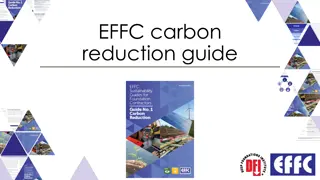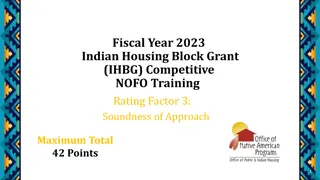Estimating for Sustainable Construction Projects
The construction industry's impact on the environment and the need for sustainability in construction projects. Evaluating the role of cost estimating in delivering sustainable construction projects.
Download Presentation

Please find below an Image/Link to download the presentation.
The content on the website is provided AS IS for your information and personal use only. It may not be sold, licensed, or shared on other websites without obtaining consent from the author.If you encounter any issues during the download, it is possible that the publisher has removed the file from their server.
You are allowed to download the files provided on this website for personal or commercial use, subject to the condition that they are used lawfully. All files are the property of their respective owners.
The content on the website is provided AS IS for your information and personal use only. It may not be sold, licensed, or shared on other websites without obtaining consent from the author.
E N D
Presentation Transcript
THE PLACE OF ESTIMATING IN THE DELIVERY OF SUSTAINABLE CONSTRUCTION PROJECT A Presentation in the Workshop organised by NIQS, at CMD Secretariat, Lagos Theme: Construction Estimating for Successful Project Delivery Dr. Abdulhakeem GARBA PhdAberdeen Department of Quantity Surveying, Kaduna Polytechnic, Kaduna hakeemgarba@gmail.com
INTRODUCTION The construction industry has a profound impact on the natural environment, public health, economy, and productivity (Darko et al., 2018). Globally, the construction industry consumes 40% of total energy production, 12-16% of all water available (Lemmet, 2009). Also, it consumes 25% of all timber, 40% of all raw materials, produces 30-40% of all solid wastes, and emits 35-40% of carbon dioxide (CO2) (Darko et al., 2018; Garba et al. 2016). These have resulted in a rising global awareness of the importance of sustainability in the construction industry (Wang et al., 2014). Rising demand for more sustainable or green buildings (GBs), over the last twenty years have witnessed an increased interest in GB concepts and practices globally (Gou and Xie, 2016). Sustainable building largely refers as Green Building has emerged as a viable solution for delivering buildings that are sustainable with limited harmful effects on the natural environment, less resource consumption and human health (Darko et al., 2018).
INTRODUCTION contd Despite the ample benefits of GB, there is still a perception that they are expensive and that green technologies are not sufficiently proven (Samosir et al., 2020). Also, the cost estimating techniques and standards method of measurements used in the conventional buildings development perhaps are not suitable and adequate for GB (Naamandadin, Sapian and Khuzzan 2014) Hence, this paper evaluates the position of cost estimating in the delivery of sustainable construction project.
CONCEPT OF GREEN BUILDING The concept of Green Building (GB) started when the awareness of sustainable development increased in the construction industry. GB awareness become more important because by the year 2050, it is predicted that almost half of the World s carbon emissions will be from developing countries (Pomeroy, 2011). GB concept has been adopted by many nations as the best way forward in preserving natural resources and sustaining our environment (Al-Kaabi et al., 2009). Chatterjee, (2009) defined sustainable building or green building as a process to create buildings and infrastructure in such a way that minimize the use of resources- energy, water and materials, reduce harmful effects on human and the environment, during the building s lifecycle. GB maximizes the use of efficient building materials and construction practices, optimizes the use of onsite sources, uses minimum energy to power itself, uses efficient equipment to meet its daily consumer consumption, maximizes the use of renewable sources of energy, uses efficient waste and water management practices.
Measures of Green Building Adopted from; Gupta and Shrivatava 2015
CONCEPT OF GREEN BUILDING Contd Site layout Hard surfacing Sustainable Site Design Optimizing the use of renewable energy to reduce electricity purchases Scheming for efficient energy utilization to reduce initial capital costs Designing for Mechanical systems of ventilation to reduce running costs Economic More Efficient Fixtures Waterless Urinals &Toilets Rainwater Reuse Grey water Reuse Water Conser.
CONCEPT OF GREEN BUILDING Contd Materials Selection and Minimizatio n Prescribing Low Energy Materials Utilizing Potential of Non-Conventional Materials and Technology Indoor Envir. Quality Natural Lighting and ventilation Passive Solar Design Reduction modulation, off-site construction Reuse Recycling Waste Minimisatio n
Strategies for Achieving Affordable GB Process- according to a growing collection of case studies, deconstruction is producing cost savings in projects throughout the U.S., often up to 40% less compared to demolition costs. Materials - there is revenue (for sale or tax benefit of donation to a non-profit t) from reused or recycled materials. Landfill fee- there is then the value of avoiding the cost of disposal. Labor costs - are higher for deconstruction than for demolition because of the manual work required to un-install materials and then process them, plus the time required to plan and organize and market/sell the salvaged materials. Time- given it takes longer to salvage and process materials for deconstruction, it s important to identify the likely savings up-front in order to make up for the time.
Emerging Skills Required by QS for Practicing Sustainability Sustainability Advisor Life cycle Costing Value Engineering Risk Analysis advisor Environmental services measurement and costing Advice on cost limits and budgets. Alternative green materials identification and specification
Myth of Sustainable Construction Projects GBs and their associated installation costs are substantially higher than conventional Buildings. GB have many advantages, but the additional construction costs of green buildings are also very important issues (Sun et al. 2019). High cost of Renewable Energy Technologies are the major barrier preventing their wider utilisation. Limited experience of construction practitioners particularly on the materials utilisation, operation systems and lack of change in the total delivery of project Majority of governments, International organisations, and other agencies set target of achieving 80% of existing building to greener buildings between 2030-2040. Globally, there is no statistical difference in the square metre cost of the buildings between those that were green and those that were not (Macaluso, 2008).
Costing Sustainable Construction Projects Developing a green project estimate requires a balancing of long term savings against initial costs. Often the approach to green building costs is to get the most Return on Investment by incorporating as many low- or no-cost green measures as possible, or in the case of a credit rating programmes, earning the most credits at the lowest cost. It is difficult to make blanket statements about the cost of a GB because of the thousands of systems and components that make up a facility, and the countless design options. How those systems (or assemblies ) are selected and interconnected and the green strategies used greatly affect both initial and future building costs.
Cost Estimating and Green Building Cost estimating is the process of projecting the cost of building a physical structure. Absence of a cost model and standard method of measurement for green home design, is causing additional cost towards the construction of green homes as compared to the traditional building development (Naamandadin, Sapian and Khuzzan 2014) Cost is one of the measures of function and performance of a building. Construction development cost does not only involve the material costs but also the method of implementation. However, improving occupant health, comfort, and productivity or pollution reduction are not easy to quantify. When considering green design and its relationship to the construction costs, the costs and benefits have to be analysed using a holistic approach. To achieve higher Green rating/marks and to minimizing life cycle impact on both new and rehabilitation programmes, it is essential to establish accurately the cost implications incurred and higher value that GB offer (Qian and Foong, 2013) .
Cost Estimating and Green Building contd In China incorporation of GB systems such as energy-efficient appliances, equipment, and lighting caused the construction costs to increase by 10.77% compared to traditional buildings. Also, in China energy efficient technology application (EETA) accounted for a large proportion (more than 50%) of the total incremental costs of GBs (Sun et al., 2019). China s GB case analysis showed that the average green premium percentage of the overall project investment in China is 10.9% According to Dahiru (2014) and Darko et al., 2017, GBs deliver projects at reduced cost. Naamandadin, Sapian and Khuzzan (2014) suggests that, to succeed in building green and to keep the costs of its design under control, three critical factors must be understood and implemented; (i) Clear goals should be determined at the very beginning in the design process, (ii) Once the sustainability goals have been defined, it is necessary to integrate them into the design, (iii) Integrate the construction team into the project team as to avoid poor construction practices.
Green Building Certification System In order to practice the goal of sustainable development, several countries launched green building promotion activities by the end of the 20th century Many countries have developed various evaluation systems and certification systems for green buildings, such as the BREEAM in the UK; LEED in the USA. Revenue considerations of GBs are also worthy of investment; however, additional construction cost associated with GB is also source of concern (Sun et al., 2019). GB certification benefits include tax incentives, visibility of commitment, increased sales and lease rates.
Green Building Economic Evaluation Techniques Following incorporation of GB components like energy-efficient appliances, equipment, and lighting caused the construction costs to increase by 10.77% compared to traditional buildings (Sun et al., 2019). Energy used in buildings accounts for nearly 50% of Carbon Dioxide emissions in the UK (John and Jones, 2019). It is indicative that energy system in building is the most contentious in terms of GB design and implementation. Hence, means of sustainable energy provision has to be subjected to economic evaluation. Renewable energy systems (RES) has been identified as the most sustainable means of energy provision in all ramifications. However, RES have been tagged exorbitant in terms of initial cost but with no/less running cost.
Green Building Economic Evaluation Techniques contd According to Short et al., (2005) there are many available techniques for economic evaluation and investment appraisal of energy systems, including net present value (NPV), levelised cost of energy (LCOE), whole life costing (WLC)), revenue requirements (RR), internal rate of return (IRR) etc. However, the most widely utilized techniques for economic evaluation in the energy sector, particularly for decentralised/self-contained supply systems are LCOE, LCC (WLC- annualized and present value), NPV. Thus, WLC is suitable for both selections between mutually exclusive options and in ranking among the same set of investment alternatives. It also has a value in determining the exact maintenance and operating costs of an asset before procurement occurs. However, the WLC approach has been criticised for not taking into account returns and benefits of investment (Short et al. 2005), but this problem can be resolved by taking the total expenditure throughout the lifespan of an asset into consideration.
Whole-life Costing Given lack of statistics or reports indicating GB are cheaper than traditional buildings at the initial cost stage development, the best strategy to evaluate GB cost estimating is through whole-life costing (WLC). WLC is defined as the sum of all expenditure related to a physical asset from the commencement stage through the operation to the end of the asset s life (Woodward 1997) Woodward & Demirag (1989) optimise the cost of acquiring, owning and operating physical assets over their useful lives by attempting to identify and quantify all the significant costs involved in that life, using the present value technique . WLC aims to assess various alternatives with a view to ensuring the adoption of the optimum asset configuration. Also, during the life phases of the assets, it allows trade-offs between cost elements to be studied so as to ensure optimum selection and enable the total cost to be realised (Woodward & Demirag 1989).
WLC and RETs Evaluation The WLC framework by Mahapatra and Dasappa (2012) has been adapted for use in the current study. The reason for selecting this WLC framework is because it is suitable for evaluating various energy sources. The framework is suitable in accommodating various trading incentive strategies. Solar PV System ?????=???+??+ ??? +?? ? ? ?,? +?? ? ?,?1 ??? ? ?,? Where ??? = ? ? ? ? ? (1)
WLC and RETs Evaluation Gridline Extension System ??????+ ??????? ? ? ? ?????= (2) Where 1 ??????= ???? ? (3) 1 ??&? (4) (5)
WLC and RETs Evaluation Contd SOLAR PV SYSTEM GRID EXTENSION SYSTEM CPV = capital cost of the photovoltic CB = capital cost of Battery = fraction of capital cost for annual operation and maintenance of system CR = component replacement cost P = present worth factor d = discount rate n = life of the project n1 = life of each component FIT= feed-in-tariff benefit h = annual operation hours L = load (kW) X = distance of the village to existing grid point L = Load demand h = annual operation hours d = discount rate n = life of the project tgen = electricity generation cost t&d = transmission and distribution losses Cgrid = grid line cost Ct = distribution transformer cost SC = gasifier rating (kg) = fraction of capital cost (for operation and maintenance of the grid)
CONCLUSION GB construction is becoming more important as we reduce the Planets s resources and seek to lessen our impact on the earth s environment. Given the raising global population vis-a-vis demand for accommodation buildings, meeting up with this demand should be through GBs system, otherwise GHG emission will increase. Recent impact of global warming such as flooding, wild bush burning, adoption of GBs construction will mitigate occurrence of these perils. More opportunities for construction practitioners particularly Quantity Surveyors in term of GB certification and more knowledge in terms of new materials utilisation among others
THANK YOU FOR LISTENING
